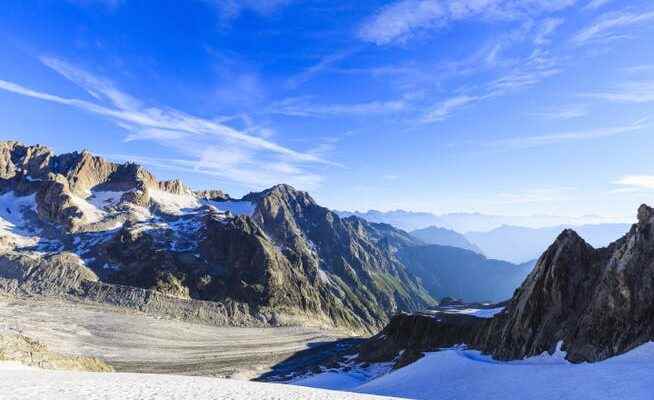The Swiss glaciers have revealed numerous human bones this hot summer. Now follows one of the most spectacular chapters in the still young history of Swiss glacier archaeology.
The Saleina Glacier in the Mont Blanc massif in the Valais Alps.
Archaeologists head to the Swiss mountains every autumn before new snow falls: it is high season for discoveries on glaciers. Wood, leather or coins – and sometimes human remains emerge from the ice, waiting to reveal their secrets.
The Saleina Glacier near Orsières in Valais recently proved to be a particularly rich treasure trove for glacier archaeologists: over the past 15 years, human bones and clothing have been discovered there time and time again, as was the case this year.
Researchers from French-speaking Switzerland have now examined these finds and determined that they are the centuries-old remains of a woman and a man who once lived in the Rhone Valley. as reported by the French-speaking Swiss television RTS.
The equipment included a kind of Nordic walking stick
“The isotopic investigations have shown that they come from the Rhone Valley,” says Romain Andenmatt from the cantonal office for archeology of the Valais RTS. “They were equipped in such a way that they must have been familiar with the mountains and must have known this area.” Their equipment included a wooden stick with an iron tip, a kind of forerunner of today’s Nordic Walking sticks.
According to the report, the couple perished in the area of the glacier between 1640 and 1800. However, the question of whether the two were actually traveling together and had an accident together has not yet been clarified. It is also possible that their remains only coincidentally appeared at the same time in the area, which extends over a length of 800 meters. The mummy parts should therefore be dated even more precisely.
It is not uncommon for the remains of glacier corpses to reappear centuries later and to be spread over such a large area, as glacier expert Christine Levy explained in an interview with the NZZ. It could indicate that the man and woman were traveling at an even higher altitude when they crashed. In any case, their corpses, sinking deeper and deeper into the ice, were literally crushed under the pressure of the overlying layers of snow and ice as they slowly moved down the valley.
Glacier archeology in Switzerland is still in its infancy…
It is also unclear why the two moved in the inhospitable area. “We can only speculate. The most likely theory is that they used a path that leads over the ice from the Col du Chardonnet over the Argentière glacier in the direction of Chamonix,” says Andenmatt.
What is certain is that this is a remarkable find in the still young history of glacier archeology. The discovery of the famous ice mummy “Ötzi” is generally considered to be the birth of the systematic scientific evaluation of finds in the ice. Others even put the emergence of this discipline another ten years later, when the North Americans and Scandinavians in particular began to search their glaciers and ice fields in a targeted manner.
…despite spectacular finds since the 1980s
Switzerland was able to come up with a case back in 1985 that is very reminiscent of the current find in western Switzerland. At that time, the mummy of a man who had died there around 1600 was discovered on the Theodul Pass in the Zermatt region. His equipment, which included coins, dagger, sword and pistol in addition to clothing and shoes, indicates that the “mercenary of Theodul”, as which the man was initially dubbed, was a trader.
In 1992, the Porchabella glacier at the foot of the Piz Kesch in the Albula region released the corpse of a young woman. Remnants of shoes, a woolen coat and a felt hat also turned up. The woman’s body remained hidden in the ice for about 300 years. Nevertheless, Swiss archaeologists still ignored their glaciers in the 1990s.
Instead, the focus continued to be on ice-free passes and high valleys, rocky outcrops and mountain flanks[, welche für Archäologen ebenfalls wahre Schatzkammern darstellen können. So fanden Forscher im Jahr 1985 unter einem Felsvorsprung auf der Alp Hermetje, am Fuss des Matterhorns, Überreste von Feuerstellen und Kristallwerkzeug sowie Tonscherben von Jägern aus der Zeit um 8000 vor Christus.]
“Schnidi” brought about a turning point in the hot summer of 2003
It was not until the hot summer of 2003 that the turning point and the actual beginning of Swiss glacier archeology came about: the hood of a Neolithic bow case appeared on the Schnidejoch, a mountain pass between the cantons of Valais and Bern. Then a bronze needle, leather trousers and shoes, a quiver, arrows and a bow.
The owner of the things remained missing. But “Schnidi”, as the Swiss public baptized him, provided the archaeologists with a rich find site. 900 objects from the Neolithic, Bronze Age, Iron Age, Roman times and the Middle Ages came to light – unique in the entire Alpine region.
Today nothing is left to chance. Interdisciplinary teams of archaeologists and geographers, glaciologists, climate researchers, mathematicians and historians regularly go in search of remains from times long past. This preferably where people were already looking for ways over the eternal ice.
Added to this is the search for missing people from recent times. The police and air force also regularly go on a search. As part of such a routine search, the Valais canton police discovered human bones on the Corbassière glacier just last week. Two skeletons had previously appeared within a few days in August – also in Valais.
